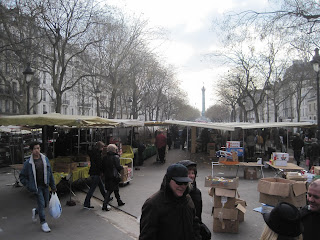No, it’s not the romanticism of the countryside encapsulated
into each radish and fromage. Those can
be found at the supermarket too, you know.
No ,it is not the chance to stroll outside in beautiful Paris. For most of the year, Paris is chilly, and
the markets of Paris do not consistently resemble the many yuppie markets of
America.
Its economics. When
it comes down to it, the markets are simply cheaper. Now, I have been contested on this statement. Sure, markets in the 7th and 15th
arrondisements are pricier, but they are within walking distance of the Eiffel
Tower and Champs Elysees, neighborhoods more upscale tourist friendly to begin
with. The vendors are not stupid. Like in America, vendors alter their prices
depending on the neighborhood. But if
one takes the road less traveled by, it may make all the difference (thank you, Robert
Frost).
 Being a resident of the 11th, I frequent the
famous Bastille Market. Taking up four
blocks, with two aisles worth of stalls (meaning four rows of stalls), the
Bastille market remains one of, if not, the largest outdoor market in Paris. The market derives its name from the Bastille,
a prison that was stormed by the people and destroyed in the beginning stages
of the French Revolution. What remains
is a monument symbolizing the importance of that day and that event. The monument sits at one end of the market
(and a metro line) making it easy to find this colossal outdoor food fair.
Being a resident of the 11th, I frequent the
famous Bastille Market. Taking up four
blocks, with two aisles worth of stalls (meaning four rows of stalls), the
Bastille market remains one of, if not, the largest outdoor market in Paris. The market derives its name from the Bastille,
a prison that was stormed by the people and destroyed in the beginning stages
of the French Revolution. What remains
is a monument symbolizing the importance of that day and that event. The monument sits at one end of the market
(and a metro line) making it easy to find this colossal outdoor food fair.
Famous historical for its size, the market abstains from
exploiting the pockets of its Parisian customers. Heads of local fresh lettuce from my favorite
produce stand sell for a euro or less.
The supermarket across the street, Simply, sells them for a euro fifty
(slug included, seriously). Cherries,
now in season, sell anywhere from 11 euros a kilo to a euro a kilo. I got mine for 1.90 a kilo, an amazing
deal. Any supermarket sells them for 8
euros a kilo at the cheapest. Oh yes,
and to make things easier, a kilo is equal to roughly 2 pounds. Yes, I too thought Paris produce quite pricey
when I arrived here, until I figured this one out.
Eggs are the most interesting of market products. From cheese vendors, to poultry vendors, to
even regular farm stands, all sell fresh eggs.
Contrary to popular belief, eggs at French markets are, for the most
part, cheaper, fresher, and healthier than the eggs at your local French
supermarket. I say for the most part,
because, like with any food purchases, you have to do your research. Who is to say an egg stand doesn’t take mass
produced eggs, and put them in a cute country wicker basket as if fresh off the
farm? It’s possible. Which is where the learning French part of my
living experience has come in handy. My
boyfriend once asked about the freshness of a fromagerie’s eggs, since we
wanted to make ouef a la coque (3 minute boiled eggs, very runny), the woman
told us that the eggs were so fresh that the egg man who delivers them sucks a
raw one out of its shell every delivery morning. Sold.
We took 4.
 |
| The pretty eggs (goose eggs too!) |
 |
| The Fromagerie we got our eggs from |
So the French frequent the markets because…they are cheap? Yes. It is not the organic that is driving the daily Parisienne markets. And it is not specialty products either, though I must say the creperie inside Bastille market, and the Lebanese stand inside the Place Monge market are worth visits in and of themselves. It is the fact that these products are cheaper and of equal or better quality.
Did I say organic? No, many products are not organic. It is the one big divide between American and
French markets. Due to the almost pure organic
products at American markets, prices are much more expensive than at the
Safeway down the street. Many French
stands do not market their products as organic, though they may very well be
organic. One has to perform the age old
dance of: asking. Okay so maybe it isn’t
as terrifying when in your mother tongue, but nevertheless, it is a shopping
habit that is quickly diminishing in this day and age. Another word for it is communication; you
know, that age old form of give and take.
It is still alive in the markets here.
And maybe for that reason—the abundance of communication—prices remain
low, and the origins of products are left to be discovered orally, word of
mouth, taste of mouth, without labels and codification.









No comments:
Post a Comment